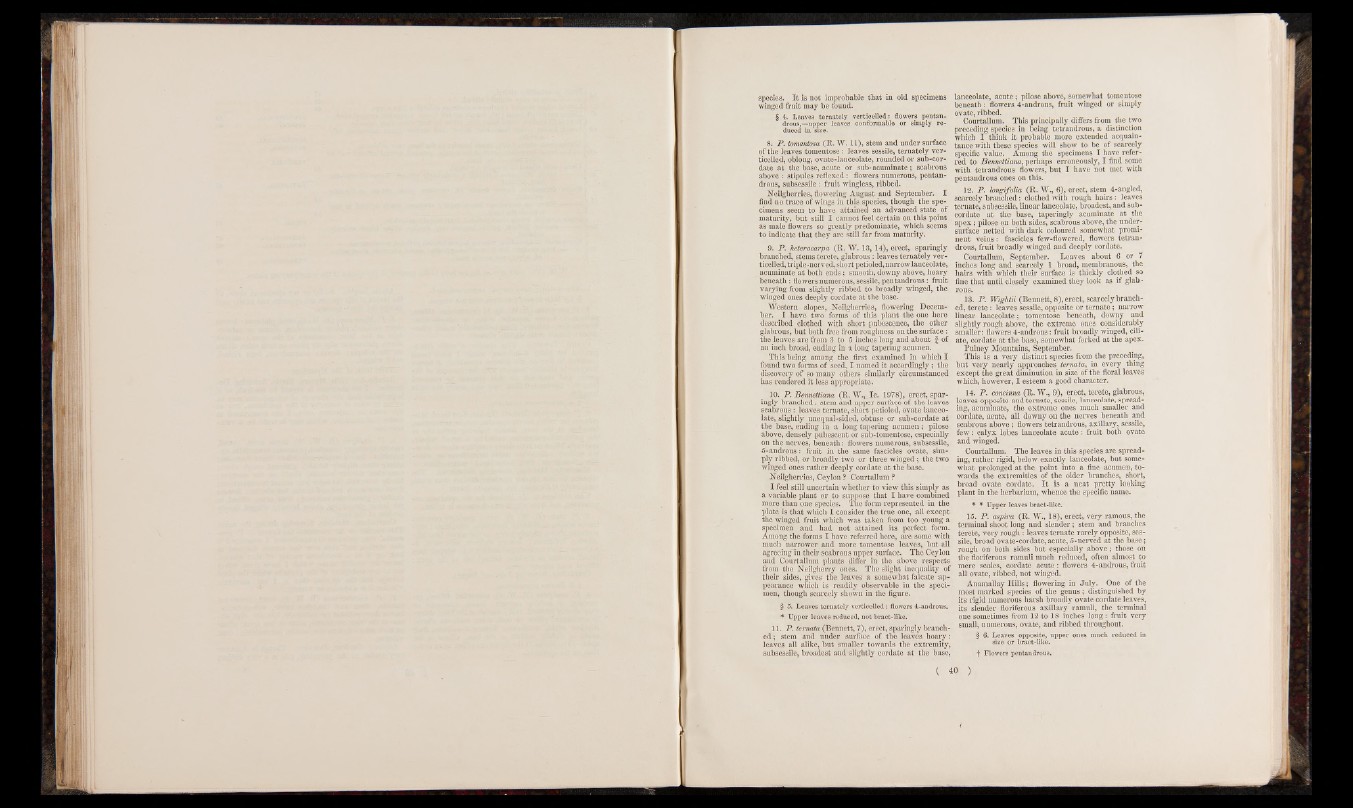
species. I t is not improbable that in old specimens
winged fruit may be found.
§ 4. Leaves ternately verticelled: flowers pentan-
drous,—upper leaves conformable or simply reduced
in size.
8. P . tomentosa (R. W. 11), stem and under surface
of the leaves tomentose: leaves sessile, ternately verticelled,
oblong, ovate-lanceolate, rounded or sub-cordate
at the base, acute or sub-acuminate; scabrous
above: stipules reflexed: flowers numerous, pentan-
drous, subsessile : fruit wingless, ribbed.
Neilgherries, flowering August and September. I
find no trace of wings in this species, though the specimens
seem to have attained an advanced state of
maturity, but still I cannot feel certain on this point
as male flowers so greatly predominate, which seems
to indicate that they are still far from maturity.
9. P . heterocarpa (R. W. 13, 14), erect, sparingly
branched, stems terete, glabrous: leaves ternately verticelled,
triple-nerved, short petioled, narrow lanceolate,
acuminate at both ends; smooth, downy above, hoary
beneath: flowers numerous, sessile, pentandrous: fruit
varying from slightly ribbed to broadly winged, the
winged ones deeply cordate at'the base.
Western slopes, Neilgherries, flowering December.
I have two forms of this plant the one here
described clothed with short pubescence, the other
glabrous, but both free from roughness on the surface:
the leaves are from 3 to 5 inches long and about f of
an inch broad, ending in a long tapering acumen.
This being among the first examined in which I
found two forms of seed, I named it accordingly; the
discovery of so many others similarly circumstanced
has rendered it less appropriate.
10. P . Bemettiana (R. W.,. Ic. 1978), erect, sparingly
branched: stem and upper surface of the leaves
scabrous : leaves ternate, short petioled, ovate lanceolate,
slightly unequal-sided, obtuse or sub-cordate at
the base, ending in a long tapering acumen; pilose
above, densely pubescent or sub-tomentose, especially
on the nerves, beneath: flowers numerous, subsessile,
5-androus: fruit in the same fascicles ovate, simply
ribbed, or broadly two or three winged; the two
winged ones rather deeply cordate at the base.
Neilgherries, Ceylon ? Courtallum ?
I feel still uncertain whether to view this simply as
a variable plant or to suppose that I have combined
more than one species. The form represented in the
plate is that which I consider the true one, all except
the winged fruit which was taken from too young a
specimen and had not attained its perfect form.
Among the forms I have referred here, are some with
much narrower and more tomentose leaves, but all
agreeingln their scabrous upper surface. The Ceylon
and Courtallum plants differ in the above respects
from the Neilgherry ones. The slight inequality of
their sides, gives the leaves a somewhat falcate appearance
which is readily observable in the specimen,
though scarcely shown in the figure.
§ 5. Leaves ternately verticelled: flowers 4-androus.
* Upper leaves reduced, not bract-like.
11. P . temata (Bennett, 7), erect, sparingly branched
; stem and under surface of the leaves hoary:
leaves all alike, but smaller towards the extremity,
subsessile, broadest and slightly cordate at the base,
lanceolate, acute; pilose above, somewhat tomentose
beneath: flowers 4-androus, fruit winged or simply
ovate, ribbed.
Courtallum. This principally differs from the two
preceding species in being tetrandrous, a distinction
which I think it probable more extended acquaintance
with these species will show to be of scarcely
specific value. Among the specimens I have referred
to Bennettiana, perhaps erroneously, I find some
with tetrandrous flowers, but I have not met with
pentandrous ones on this.
12. P . longifolia (R. W., 6), erect, stem 4-angled,
scarcely branched: clothed with rough h a irs: leaves
ternate, subsessile, linear lanceolate, broadest, and sub-
cordate at the base, taperingly acuminate at the
ap e x ; pilose on both sides, scabrous above, the undersurface
netted with dark coloured somewhat prominent
veins: fascicles few-flowered, flowers tetrandrous,
fruit broadly winged and deeply cordate.
Courtallum, September. Leaves about 6 or 7
inches long and scarcely 1 broad, membranous, the
hairs with which then* surface is thickly clothed so
fine that until closely examined they look as if glabrous.
13. P . Wightii (Bennett, 8), erect, scarcely branched,
tere te: leaves sessile, opposite or ternate; narrow
linear lanceolate; tomentose beneath, downy and
slightly rough above, the extreme ones considerably
smaller: flowers 4-androus: fruit broadly winged, cili-
ate, cordate at the base, somewhat forked at the apex.
Pulney Mountains, September.
This is a very distinct species from the preceding,
but very nearly approaches ternata, in every thing
except the great diminution in size of the floral leaves
which, however, I esteem a good character.
14. P . concinna (R. W., 9), erect, terete, glabrous,
leaves opposite and ternate, sessile, lanceolate, spreading,
acuminate, the extreme ones much smaller and
cordate, acute, all downy on the nerves beneath and
scabrous above; flowers tetrandrous, axillary, sessile,
few: calyx lobes lanceolate acute: fruit both ovate
and winged.
Courtallum. The leaves in this species are spreading,
rather rigid, below exactly lanceolate, but somewhat
prolonged at the point into a fine acumen, towards
the extremities of the older branches, short,
broad ovate cordate. I t is a neat pretty looking
plant in the herbarium, whence the specific name.
* * Upper leaves bract-like.
15. P . aspira (R. W., 18), erect, very ramous, the
terminal shoot long and slender; stem and branches
terete, very rough: leaves ternate rarely opposite, sessile,
broad ovate-cordate, acute, 5-nerved at the base;
rough on both sides but especially above; those on
the floriferous ramuli much reduced, often almost to
mere scales, cordate acute: flowers 4-androus, fruit
all ovate, ribbed, not winged.
Anamallay Hills; flowering in July. One of the
most marked species of the genus; distinguished by
its rigid numerous harsh broadly ovate cordate leaves,
its slender floriferous axillary ramuli, the terminal
one sometimes from 12 to 18 inches long: fruit very
small, numerous, ovate, and ribbed throughout.
§ 6. Leaves opposite, upper ones much reduced in
size or bract-like,
f Flowers pentandrous.